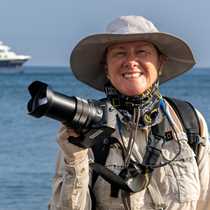Pahuachiro, San Francisco & Yarapa River
For the avid birders on board, early this morning—very early—we got together a small group who went ashore on a trail that led into the flood forest. For us, it’s a new trail, but it was made by a local of the area who uses it on occasion. We used the trail for the first time last night for a hike, and now at dawn it looked different, yet some landmarks looked familiar. Our outing was quite successful and our patience paid off in the form of plum-throated cotinga and paradise tanager (my personal favorite). Woodpeckers and woodcreepers were found; perhaps the best of all were the early morning calls of the thrush-like wren, piratic flycatcher, and chachalacas.
Others left by skiff this morning and also had good sightings including a close view of a three-toed sloth, so all was well with the world when we met up for breakfast back on board.
Remember that the Amazon Basin has had people living here for thousands of years. In addition, since the arrival of the Europeans in the 1500’s, a mixed-race group of people with heritage from Europe and Africa have moved up the river from the east and settled the length and breadth of the Amazon basin. These “ribereños” are hard-working people whose economy and lifestyle center on fishing.
In the latter part of the morning we visited a community called San Francisco of about 400 people. This is one of two communities in particular that have worked hard at improving the quality of their handcrafts, and so our intention was to help them out a bit (quite a bit). But also it gave us an opportunity to visit a town and for a few minutes at least, peek into their lives, and lifestyles…including a shop and a school. That class would be disrupted by our visit was to be expected, but since it was a learning experience for all, I think the professor considered it a productive break in the routine.
Just 20 minutes downriver from San Francisco lies the confluence of the Marañon and Ucayali rivers…meaning the Amazon River begins. To celebrate our arrival in this historic place on the globe, eight of us jumped into a skiff, left the Delfin II behind, and then promptly jumped into the water! The water is café-au-lait in color, you can’t see your hands a couple inches below the water, and it’s considered one of the cleanest waters in the world. A heavy sediment load, yes, but that is all. So those of us who braved the anacondas, caiman, and piranha returned with life-long bragging rights to our names…we swam at the beginning of the Amazon!
The afternoon was spent in a more leisurely activity, although some folks opted for kayaking on the Cumaceba River. The skiff riders took off up the Yarapa a long distance, and it turned out about right for everyone. One of the skiffs got a look at night monkeys far up in a tree inside a dark forest…but very cool all the same.




